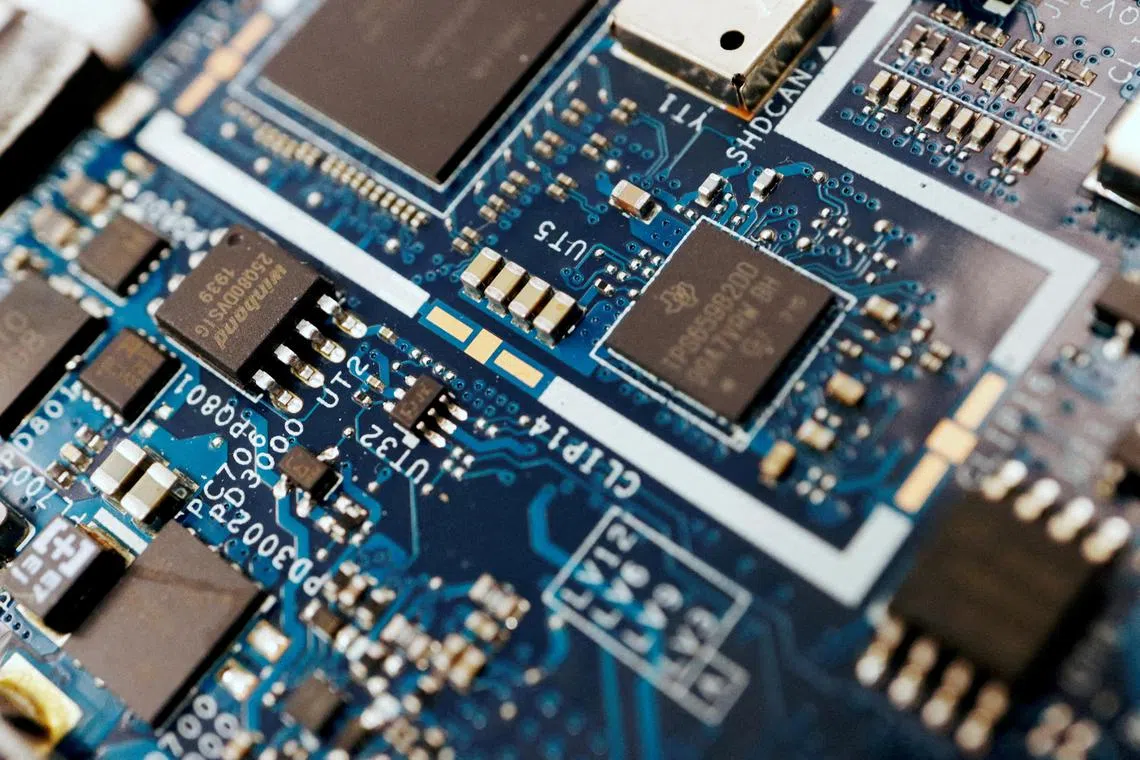India’s semiconductor sector heats up amid US support
Sign up now: Get insights on Asia's fast-moving developments

Experts believe it will take time to set up a chip manufacturing ecosystem in India.
PHOTO: REUTERS
Follow topic:
NEW DELHI - India’s semiconductor space is heating up, with the country likely to be a beneficiary of the tussle between the United States and China for technological supremacy.
The US, which in 2022 introduced export controls, among other measures, to restrict the sale of chips or chip-making equipment to China,
The two countries discussed “bilateral collaboration on resilient semiconductor supply chains” and manufacturing at the inaugural meeting of the India-US Initiative on Critical and Emerging Technology on Feb 1.
The talks took place a day after the US Semiconductor Industry Association and the India Electronics and Semiconductor Association set up a task force to explore private initiatives on semiconductors.
A day after the talks, American firm General Atomics (GA) announced that it had partnered Indian start-up 3rdiTech to co-develop semiconductor technologies. The two companies will develop products for the defence sector.
“With GA, we have a deep strategic partnership to co-create and co-innovate semiconductor products that will serve integral national security interests,” said a statement from 3rdiTech.
It noted that semiconductors enable communication, precision guidance and vision during the night and in poor weather, all of which are essential for any modern military.
The plans for US-India cooperation come in the wake of a flurry of announcements over the past six months in the Indian semiconductor industry.
Foxconn, a Taiwanese multinational electronics contract manufacturer, has formed a joint venture worth US$19.5 billion (S$27.9 billion) with India’s Vedanta Group to make semiconductors in the western state of Gujarat.
The joint venture has applied for government incentives to set up a semiconductor fab, which is a plant that manufactures integrated circuits from raw silicon wafers, in Dholera, in Gujarat.
Vedanta chairman Anil Agarwal said on Tuesday that the target is to manufacture 40,000 wafers a month in around 2½ years.
Meanwhile, Israel-based International Semiconductor Consortium is looking at investing US$3 billion to set up a fabrication plant in the southern state of Karnataka.
Tata Sons is also going to build a “semiconductor assembly testing business” and was in talks with other firms, its chairman Natarajan Chandrasekaran said in December 2022.
Plans such as these are being fuelled by a US$10 billion government incentive programme covering up to 50 per cent of project costs, which was announced in 2021 to attract chip manufacturers to India.
Across the globe, the disruptions caused by the Covid-19 pandemic have triggered a race to set up semiconductor manufacturing capacities and diversify supply chains.
Semiconductors are used in everything from smartphones and laptops to cars and military equipment. Global production lines were impacted due to the shortage of chips during the pandemic.
Taiwan dominates the industry, which has an estimated market worth of around US$500 billion globally. Taiwan Semiconductor Manufacturing Company alone accounts for around 50 per cent of global semiconductor production.
Other countries and regions have also announced plans to ramp up domestic production of semiconductors on the back of estimates that the size of the industry will double by 2030. For instance, the European Union plans to provide billions in financial support to set up factories for advanced chip production.
Experts believe it will take time to set up a chip manufacturing ecosystem in India. “I feel it will take two to three years for this ecosystem to take off. Things will start moving on the ground once the government announces which firms have been picked under the incentives scheme,” said Mr Rajeev Khushu, the India working group chairman for the Semiconductor Industry Association.
While India lacks manufacturing capabilities, it has capacities in semiconductor research and design, besides the advantage of a cheap workforce and an industrial base.
“India’s strength has been in semiconductor design. Close to 20 per cent of global semiconductor design happens in the country and this has happened organically without any incentive,” said Mr Khushu.
Experts also indicate that India needs to move quickly to take advantage of the current global environment.
“After many decades of missing out on the semiconductor industry in general and commercial silicon fabs in particular, India is now trying to get them by offering incentives. Mature technology node silicon fabs, as well as other associated industries, have scope in India,” said Mr Arun Mampazhy, a semiconductor engineer.
“The plan to launch a (semiconductor incentive) scheme was announced in the Budget of July 2019. It took 2½ years to launch the scheme in December 2021, and 14 months after that, no applicant has been approved yet under any category. Multiple deadlines... have passed by,” he added.
The government remains optimistic that India can quickly scale up capabilities.
“This is a long haul and will require a lot of persistence and lots of effort,” noted Minister of Electronics and Information Technology Ashwini Vaishnaw at the World Economic Forum in Davos in January, adding that India was aiming to become a key global supplier.


